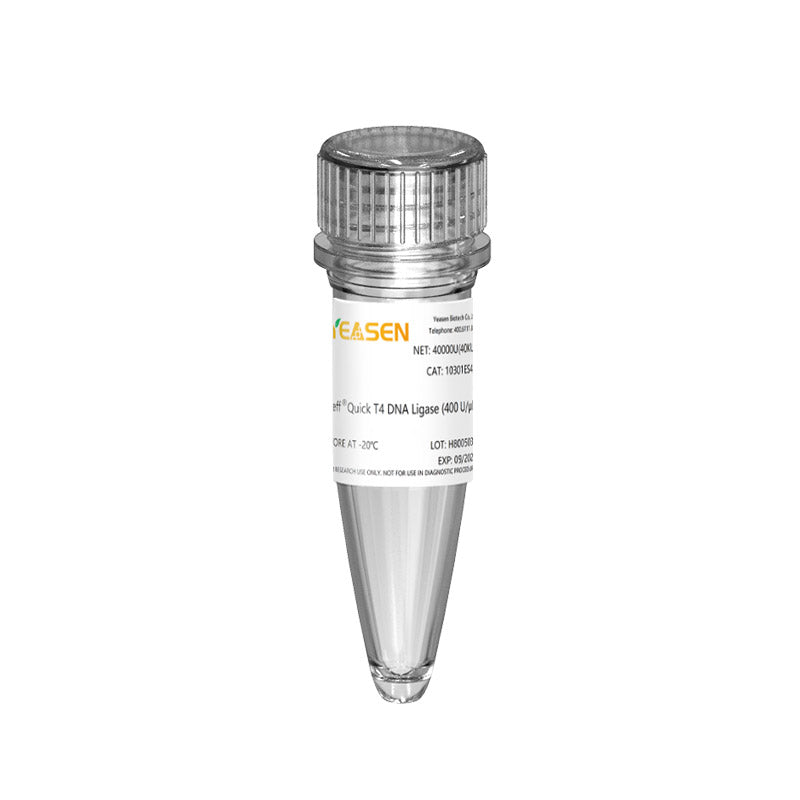Description
Quick T4 DNA Ligase is a single enzyme product that can be used for the ligation of DNA fragments and adapters in the process of NGS library construction. This product has been verified by high-throughput sequencing and has excellent quality. For customers who do not need experimental system adjustment, it is recommended to purchase Hieff NGSTM Fast-Pace DNA Ligation Module (Cat#12607).
Product Components
|
Component number |
Components |
10301ES40 |
10301ES42 |
|
10301-A |
Quick T4 DNA Ligase (400 U/µL) |
100 µL |
1 mL |
|
10301-B |
10 × T4 DNA Ligase Buffer |
250 µL |
2×1,250 µL |
Shipping and Storage
The product is shipped with ice packs and can be stored at -20°C for two years.
Unit Definition
In a 20 μL ligation reaction system, when 6 μg of λDNA-Hind Ⅲ is reacted at 16℃ for 30 mins, the amount of enzyme required to give more than 50% ligation of the DNA fragments was defined as one unit (U).
Cautions
1. If a small amount of precipitation occurs when the buffer is melting, please invert and mix well before use;
2. For your safety and health, please wear lab coats and disposable gloves for operation.
3. This product is for research use ONLY!
Instructions
1. The current mainstream DNA library construction kits are generally not purified after end repair and A-Tailing treatment, and directly perform adapter ligation. Please refer to the following preparation for the reaction system. Vortex thoroughly, spin briefly and incubate for 15 min at 20°C.
|
Components |
Volume (μL) |
|
dA-tailed DNA |
60 |
|
10 × T4 DNA Ligase Buffer |
10 |
|
50% PEG 6000 |
10* |
|
DNA Adapter |
X** |
|
Quick T4 DNA Ligase |
1-5*** |
|
ddH2O |
Up to 100 |
[Note]: *50% PEG 6000 is not provided in the kit, you need to prepare it by yourself.
**Refer to the following table for the amount of adapters.
***The amount of Quick T4 DNA Ligase used can be added 1-5 μL as needed.
2. The quality and concentration of adapters used directly affect ligation efficiency and library yield. Too much adapter usage may produce more adapter dimers, while lower usage may affect ligation efficiency and library yield. The following table lists the recommended amount of adapters used in different Input DNA situations using this kit.
|
Input DNA |
Adapter: Input DNA (molar ratio) |
Input DNA |
Adapter: Input DNA (molar ratio) |
|
1 μg |
10:1 |
50 ng |
100:1 |
|
500 ng |
20:1 |
25 ng |
200:1 |
|
250 ng |
40:1 |
1 ng |
200:1 |
|
100 ng |
100:1 |
500 pg |
400:1 |
[Note]: Input DNA mole (pmol)≈ Input DNA(ng)/ [0.66 × Input DNA average length(bp)].
Adapter ligation calculation example: How much adapter should be added when input DNA is 100 ng and length is 300 bp?
Step 1: Calculate the number of moles of input DNA. Formula: Input DNA mole (pmol)≈ Input DNA(ng)/ [0.66 × Input DNA average length(bp)]; Input DNA mole (pmol)=100 ÷ (0.66×300) = 0.5 pmol;
Step 2: According to the above table, calculate the number of moles of adapter added.; When the Input DNA is 100ng, the molar ratio of adapters: input DNA is 100:1, and the number of moles of adapters added=100×0.5 pmol=50 pmol;
Step 3: Calculate the adapter addition volume. Adapter concentration = 15 μmol/L (if you use other company's adapter, you need to determine its concentration according to its instructions); Volume of adapter added = moles of adapter added (50 pmol) ÷ concentration of adapter (15 μmol/L) = 3.34 μL (Note: 15 μmol/L = 15 pmol/ μL);
In summary, the volume to which the adapter can be added is 3.4 μL. (Note: The maximum addition volume of the adapter does not exceed 5 μL).
ase buffer.
Payment & Security
Your payment information is processed securely. We do not store credit card details nor have access to your credit card information.
Inquiry
You may also like
FAQ
The product is for research purposes only and is not intended for therapeutic or diagnostic use in humans or animals. Products and content are protected by patents, trademarks, and copyrights owned by Yeasen Biotechnology. Trademark symbols indicate the country of origin, not necessarily registration in all regions.
Certain applications may require additional third-party intellectual property rights.
Yeasen is dedicated to ethical science, believing our research should address critical questions while ensuring safety and ethical standards.

